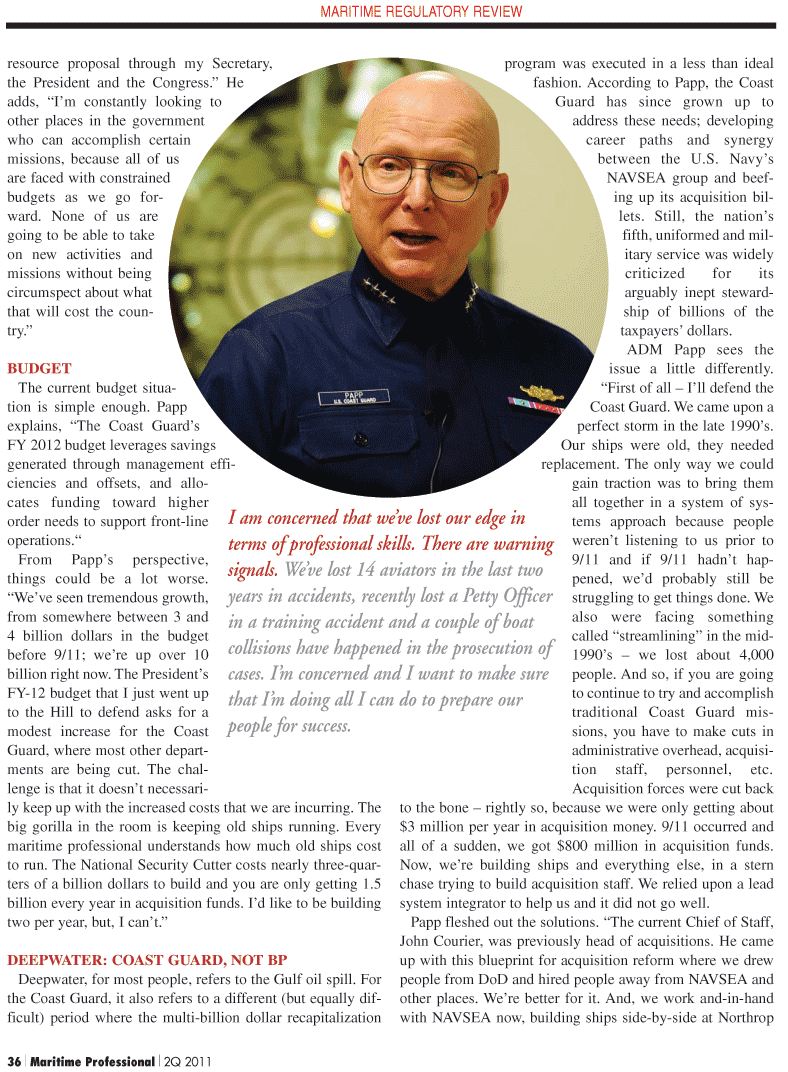
Page 36: of Maritime Logistics Professional Magazine (Q2 2011)
Energy Transportation
Read this page in Pdf, Flash or Html5 edition of Q2 2011 Maritime Logistics Professional Magazine
36 Maritime Professional 2Q 2011 resource proposal through my Secretary, the President and the Congress.” He adds, “I’m constantly looking to other places in the government who can accomplish certain missions, because all of us are faced with constrained budgets as we go for- ward. None of us are going to be able to take on new activities and missions without being circumspect about what that will cost the coun- try.”
BUDGET
The current budget situa- tion is simple enough. Papp explains, “The Coast Guard’s
FY 2012 budget leverages savings generated through management effi- ciencies and offsets, and allo- cates funding toward higher order needs to support front-line operations.“
From Papp’s perspective, things could be a lot worse. “We’ve seen tremendous growth, from somewhere between 3 and 4 billion dollars in the budget before 9/11; we’re up over 10 billion right now. The President’s
FY-12 budget that I just went up to the Hill to defend asks for a modest increase for the Coast
Guard, where most other depart- ments are being cut. The chal- lenge is that it doesn’t necessari- ly keep up with the increased costs that we are incurring. The big gorilla in the room is keeping old ships running. Every maritime professional understands how much old ships cost to run. The National Security Cutter costs nearly three-quar- ters of a billion dollars to build and you are only getting 1.5 billion every year in acquisition funds. I’d like to be building two per year, but, I can’t.”
DEEPWATER: COAST GUARD, NOT BP
Deepwater, for most people, refers to the Gulf oil spill. For the Coast Guard, it also refers to a different (but equally dif- ficult) period where the multi-billion dollar recapitalization program was executed in a less than ideal fashion. According to Papp, the Coast
Guard has since grown up to address these needs; developing career paths and synergy between the U.S. Navy’s
NAVSEA group and beef- ing up its acquisition bil- lets. Still, the nation’s fifth, uniformed and mil- itary service was widely criticized for its arguably inept steward- ship of billions of the taxpayers’ dollars.
ADM Papp sees the issue a little differently. “First of all – I’ll defend the
Coast Guard. We came upon a perfect storm in the late 1990’s.
Our ships were old, they needed replacement. The only way we could gain traction was to bring them all together in a system of sys- tems approach because people weren’t listening to us prior to 9/11 and if 9/11 hadn’t hap- pened, we’d probably still be struggling to get things done. We also were facing something called “streamlining” in the mid- 1990’s – we lost about 4,000 people. And so, if you are going to continue to try and accomplish traditional Coast Guard mis- sions, you have to make cuts in administrative overhead, acquisi- tion staff, personnel, etc.
Acquisition forces were cut back to the bone – rightly so, because we were only getting about $3 million per year in acquisition money. 9/11 occurred and all of a sudden, we got $800 million in acquisition funds.
Now, we’re building ships and everything else, in a stern chase trying to build acquisition staff. We relied upon a lead system integrator to help us and it did not go well.
Papp fleshed out the solutions. “The current Chief of Staff,
John Courier, was previously head of acquisitions. He came up with this blueprint for acquisition reform where we drew people from DoD and hired people away from NAVSEA and other places. We’re better for it. And, we work and-in-hand with NAVSEA now, building ships side-by-side at Northrop
MARITIME REGULATORY REVIEW
I am concerned that we’ve lost our edge in terms of professional skills. There are warning signals. We’ve lost 14 aviators in the last two years in accidents, recently lost a Petty Officer in a training accident and a couple of boat collisions have happened in the prosecution of cases. I’m concerned and I want to make sure that I’m doing all I can do to prepare our people for success.

 35
35

 37
37
